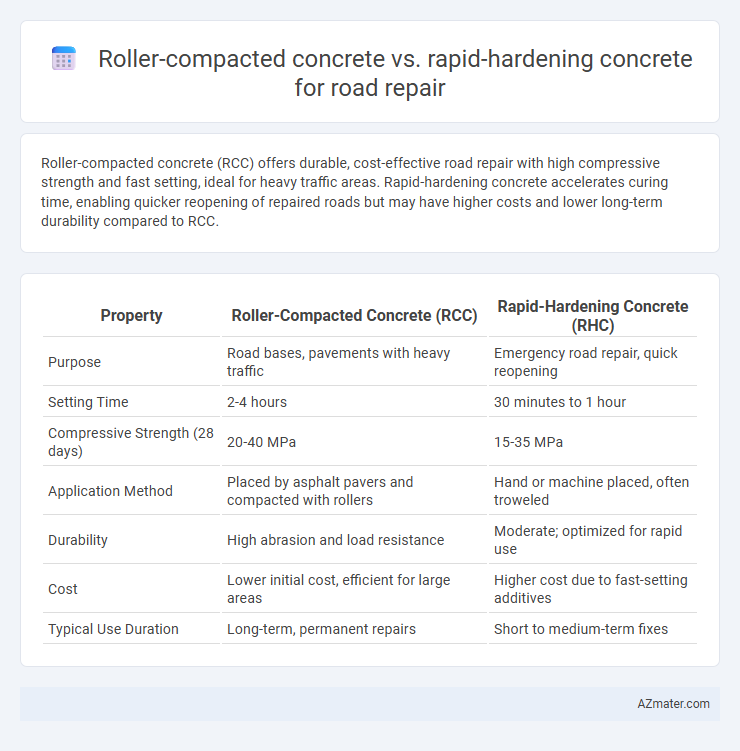Roller-compacted concrete (RCC) offers durable, cost-effective road repair with high compressive strength and fast setting, ideal for heavy traffic areas. Rapid-hardening concrete accelerates curing time, enabling quicker reopening of repaired roads but may have higher costs and lower long-term durability compared to RCC.
Table of Comparison
| Property | Roller-Compacted Concrete (RCC) | Rapid-Hardening Concrete (RHC) |
|---|---|---|
| Purpose | Road bases, pavements with heavy traffic | Emergency road repair, quick reopening |
| Setting Time | 2-4 hours | 30 minutes to 1 hour |
| Compressive Strength (28 days) | 20-40 MPa | 15-35 MPa |
| Application Method | Placed by asphalt pavers and compacted with rollers | Hand or machine placed, often troweled |
| Durability | High abrasion and load resistance | Moderate; optimized for rapid use |
| Cost | Lower initial cost, efficient for large areas | Higher cost due to fast-setting additives |
| Typical Use Duration | Long-term, permanent repairs | Short to medium-term fixes |
Introduction to Road Repair Materials
Roller-compacted concrete (RCC) and rapid-hardening concrete serve crucial roles in road repair by offering distinct performance benefits tailored to varying project demands. RCC provides a durable, cost-effective solution characterized by its dense, low-slump mix suitable for high-traffic roads, while rapid-hardening concrete excels in reducing downtime with its fast strength gain, enabling quicker reopening of repaired pavement sections. Selection between these materials depends on factors like traffic load, environmental conditions, and repair urgency, ensuring optimized longevity and minimal disruption.
Overview of Roller-Compacted Concrete (RCC)
Roller-compacted concrete (RCC) is a dry-mix concrete placed and compacted with heavy rollers, offering high strength and durability for road repair with minimal curing time. RCC's low water content and dense compaction create a robust pavement structure ideal for high-traffic highways and industrial flooring. The material's cost-effectiveness and rapid construction capabilities make it a preferred choice compared to traditional concrete methods.
Overview of Rapid-Hardening Concrete
Rapid-hardening concrete achieves high early strength by incorporating Type III Portland cement or special additives, enabling road repairs to be completed in hours rather than days. Its accelerated setting time supports rapid reopening of traffic, minimizing downtime on highways and urban streets. Compared to roller-compacted concrete, which is dense and suitable for heavy-duty pavements, rapid-hardening concrete excels in fast turnaround repairs requiring minimal curing periods.
Key Material Properties Comparison
Roller-compacted concrete (RCC) offers high compressive strength ranging from 20 to 35 MPa within 7 days, providing excellent durability and load-bearing capacity for road repair, while rapid-hardening concrete achieves early strength as high as 20 MPa within 24 hours, enabling faster project turnaround. RCC exhibits low permeability and high abrasion resistance, making it suitable for heavy traffic conditions, whereas rapid-hardening concrete features reduced setting time and enhanced sulfate resistance valuable for rapid patching in aggressive environments. Both materials have distinct water-cement ratios, with RCC typically around 0.35 to 0.45 for workability and compaction, versus rapid-hardening concrete's lower water-cement ratio around 0.3 to 0.4 to maximize early strength development.
Construction Process and Speed
Roller-compacted concrete (RCC) uses a drier mix placed and compacted with heavy rollers, enabling rapid pavement construction with minimal formwork and jointing, ideal for large-scale road repair projects requiring high durability. Rapid-hardening concrete (RHC) incorporates specialized cementitious materials that accelerate strength gain, allowing reopening to traffic within hours and reducing downtime on critical road repairs. RCC offers efficiency through continuous layering and compaction, while RHC prioritizes ultra-fast strength development for rapid lane restoration and emergency repairs.
Curing Times and Traffic Reopening
Roller-compacted concrete (RCC) achieves initial curing within 24 hours, allowing for moderate traffic reopening typically after 3 days, making it suitable for roads requiring durability and heavy load resistance. Rapid-hardening concrete (RHC) exhibits significantly faster curing times, often reaching sufficient strength within 6 to 12 hours, which enables traffic reopening as soon as the day of application or the next morning. For urgent road repairs demanding minimal downtime, rapid-hardening concrete offers a superior solution by minimizing traffic disruption due to its expedited curing and strength gain.
Durability and Longevity
Roller-compacted concrete (RCC) offers exceptional durability due to its dense structure and lower permeability, making it highly resistant to freeze-thaw cycles and heavy traffic loads in road repair applications. Rapid-hardening concrete gains advantage in faster curing times, enabling quicker reopening of roads, but it may exhibit slightly reduced long-term durability compared to RCC under extreme environmental conditions. The choice between RCC and rapid-hardening concrete should consider the balance between immediate traffic restoration needs and projected lifespan under anticipated stress factors.
Cost Analysis and Budget Considerations
Roller-compacted concrete (RCC) typically offers lower initial costs due to reduced cement content and faster placement methods, making it ideal for large-scale road repair projects on tight budgets. Rapid-hardening concrete incurs higher material costs but enables quicker traffic reopening, reducing economic losses from road closures. Budget considerations must balance RCC's cost efficiency against rapid-hardening concrete's advantage in minimizing downtime and associated indirect costs.
Best Use Cases for RCC vs Rapid-Hardening Concrete
Roller-compacted concrete (RCC) excels in large-scale road repair projects requiring high durability, rapid construction, and cost-efficiency, particularly for highways and industrial pavements due to its dense, low-slump consistency and efficient placement using heavy rollers. Rapid-hardening concrete is ideal for emergency road repairs and areas with minimal downtime tolerance, providing faster strength gain within hours, making it suitable for airport runways, urban road patches, and critical traffic intersections. The choice depends on balancing early strength requirements, project scale, cost constraints, and equipment availability for compaction or rapid curing.
Conclusion: Choosing the Right Concrete for Road Repairs
Roller-compacted concrete (RCC) offers enhanced durability and load-bearing capacity, making it ideal for heavy-traffic road repairs requiring long-term performance. Rapid-hardening concrete (RHC) excels in fast-setting properties, enabling quicker reopening of roads with minimal downtime, crucial for emergency repairs and high-speed construction. Selecting between RCC and RHC depends on balancing project timelines, traffic demands, and durability requirements to optimize road repair efficiency and lifespan.

Infographic: Roller-compacted concrete vs Rapid-hardening concrete for Road repair
 azmater.com
azmater.com